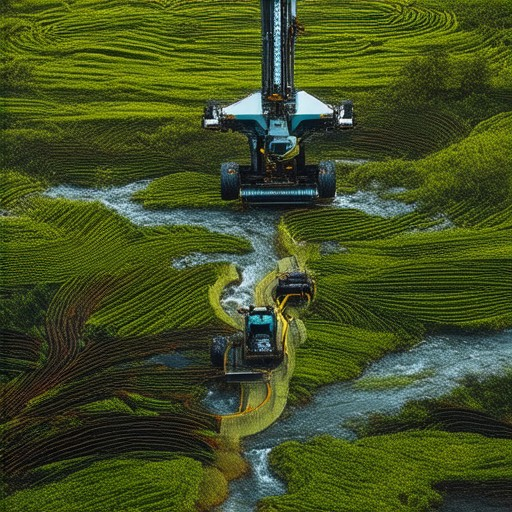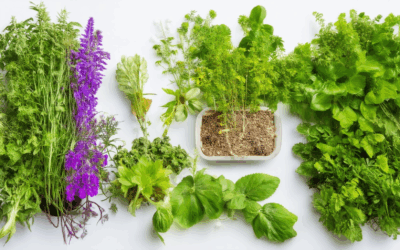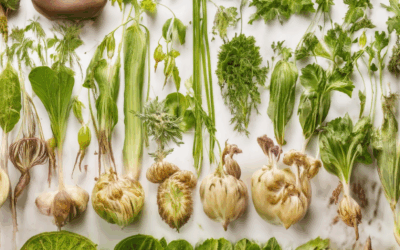Modern agriculture faces significant challenges, from environmental degradation to diminishing natural resources. In this rapidly evolving landscape, farmers are increasingly seeking innovative solutions to enhance productivity while preserving the planet for future generations. One such approach that has gained traction is the concept of alternative farming techniques, which offer a sustainable way to manage land, water, and energy. By exploring these methods, we aim to shed light on how they can transform traditional farming practices, providing answers to some of the most pressing questions in agriculture today. From understanding what constitutes an alternative farm to discovering the latest farming techniques that minimize environmental impact, this article delves into the world of sustainable farming practices and their profound implications for the industry.
What is an Alternative Farm?
Alternative farming refers to agricultural practices that deviate from conventional methods, focusing on sustainability, environmental health, and often social equity. These systems aim to optimize resources while minimizing harm to ecosystems and promoting long-term productivity.
Key Models of Alternative Farming:
- Permaculture : Emphasizes designing self-sustaining ecosystems that mimic natural patterns, incorporating edible plants, beneficial insects, and animals to maximize biodiversity and resource efficiency.
- Agroforestry : Integrates trees, crops, and livestock to create a harmonious farm environment, improving soil health and providing shade, erosion control, and additional food products.
- Organic Farming : Rejects synthetic chemicals, relying instead on natural processes like composting and crop rotation to maintain soil fertility and reduce pesticide use.
- Community Supported Agriculture (CSA) : A cooperative model where consumers subscribe to receive shares of produce directly from local farmers, fostering community ties and reducing reliance on industrial distribution channels.
- Urban Farming : Utilizes unconventional spaces like rooftops, balconies, and containers to grow vegetables, herbs, and fruits in urban environments, promoting local food production.
- Regenerative Agriculture : Focuses on rebuilding soil health and increasing biodiversity through practices like cover cropping, crop diversification, and integrated grazing, aiming to restore ecosystems to a state of resilience.
- Holistic Farming : Considers the farm as a whole ecosystem, incorporating animals, plants, and beneficial organisms to create a balanced, self-reliant system.
These models share common goals of environmental stewardship, economic viability, and social benefit, making alternative farming a vital part of building a sustainable future. At Old Seed, we champion these practices through heirloom seed preservation and sustainable gardening resources, helping individuals contribute to a greener world. Explore our collection of heirloom seeds and learn how to implement these methods in your own garden.
What Are the New Methods of Farming?
Farming has evolved significantly in recent years, adopting innovative techniques that enhance sustainability, efficiency, and productivity. These methods not only address environmental challenges but also improve food security and agricultural outcomes.
1. Precision Agriculture
Precision agriculture uses technology like GPS, drones, and sensors to optimize resource use. By monitoring soil health, water usage, and crop conditions, farmers can apply inputs precisely, reducing waste and environmental impact.
- GPS-guided machinery for planting and spraying
- Drones for crop scouting and pest detection
- Sensors for real-time data collection
- Variable rate technology for input application
Learn more about precision agriculture
2. Vertical Farming
Vertical farming involves growing crops in controlled environments, often in urban settings. This method uses less land, reduces transportation emissions, and increases production capacity.
- High-tech grow rooms with controlled lighting and temperature
- Use of hydroponics and aeroponics systems
- Crop rotation to maximize space utilization
- Reduced reliance on pesticides and chemicals
Explore vertical farming techniques
3. Regenerative Agriculture
Regenerative agriculture focuses on rebuilding soil health and increasing biodiversity. Practices include cover cropping, composting, and reducing tillage to enhance carbon sequestration and soil fertility.
- Cover cropping to protect soil and improve nitrogen fixation
- Composting to recycle organic waste into nutrient-rich amendments
- Intercropping to diversify plant species and improve pollination
- Reducing tillage to prevent soil degradation
Discover regenerative farming practices
4. Agroforestry
Agroforestry integrates trees and crops together, mimicking natural forest ecosystems. This approach enhances soil fertility, provides shade for plants, and improves biodiversity.
- Planting trees alongside crops to create shaded microclimates
- Using trees as windbreaks and erosion control measures
- Improving soil structure through tree roots and leaf litter
- Providing nutritious pods, fruits, and nuts for human consumption
Find out about agroforestry systems
5. Biochar
Biochar is a carbon-rich material produced from organic waste through pyrolysis. It acts as a soil amendment, enhancing microbial activity and improving soil health.
- Produced from organic materials like wood chips or manure
- Applied to soil to increase carbon content and water retention
- Enhances microbial growth and nutrient availability
- Reduces greenhouse gas emissions by sequestering carbon
Learn about biochar benefits
6. Crop Rotation
Crop rotation involves growing different types of crops in sequence to maintain soil health and reduce pests and diseases. This practice improves long-term yields and sustainability.
- Rotating crops like corn, soybeans, and wheat
- Breaking pest life cycles by changing crop types
- Improving soil nutrients by introducing varied plant types
- Reducing the need for synthetic fertilizers
Understand crop rotation benefits
7. Cover Cropping
Cover cropping involves planting temporary crops to cover bare soil, protecting it from erosion and improving soil structure. These crops also provide habitats for beneficial insects.
- Protects soil from erosion and water runoff
- Improves soil organic matter and fertility
- Provides habitat for pollinators and beneficial insects
- Reduces the need for tillage between cash crops
Discover cover cropping techniques
8. Organic Farming
Organic farming relies on natural processes and excludes synthetic chemicals. It focuses on building healthy soils, using natural pest controls, and rotating crops to maintain balance.
- No use of synthetic pesticides, herbicides, or fertilizers
- Emphasis on natural pest control methods
- Building healthy soil through composting and cover cropping
- Increasing biodiversity with diverse crop varieties
Explore organic farming methods
9. Precision Irrigation
Precision irrigation delivers water directly to specific areas of the field, reducing waste and improving water efficiency. Sensors and software monitor soil moisture levels and adjust irrigation accordingly.
- Smart irrigation systems using sensor data
- Zoned irrigation for targeted water application
- Automatic irrigation based on soil moisture
- Water conservation through efficient delivery
Master precision irrigation techniques
What Farming Method is the Most Environmentally Friendly?
The most environmentally friendly farming method depends on specific goals and contexts, but several approaches stand out for their sustainability:
- Hydroponics : Known for water conservation and reduced chemical use, hydroponics is ideal for resource-efficient urban farming. It eliminates soil damage and offers a controlled growing environment.
- Organic Farming : Emphasizes natural fertilizers like compost and avoids synthetic pesticides. It preserves soil health and reduces contamination risks, making it a sustainable choice.
- Agroforestry : Integrates trees with crops, enhancing soil health, reducing erosion, and capturing carbon dioxide. It promotes biodiversity and long-term ecosystem resilience.
- Permaculture : Mimics natural ecosystems using techniques like mulching and companion planting. It reduces external inputs and builds self-sufficient, pest-resistant systems.
- Vertical Farming : Efficiently uses space and often employs hydroponics. While it may have higher energy costs, it significantly reduces land use compared to conventional farming.
Each method excels in different areas, from water conservation (hydroponics) to biodiversity enhancement (agroforestry and permaculture). Consider environmental impact, resource availability, and scalability when choosing the best approach for your situation.
For deeper insights and practical guides, explore Old Seed ‘s resources on sustainable farming methods.
What Are Some Poor Farming Techniques?
The following farming techniques are considered poor due to their negative impact on sustainability, productivity, and environmental health:
- Overuse of Chemical Fertilizers : Excessive reliance on synthetic fertilizers can deplete soil nutrients, lead to nutrient imbalances, and contribute to environmental pollution. It also reduces biodiversity and long-term soil fertility.
- Excessive Irrigation : Overirrigating can waste water, increase waterlogging, and harm soil structure. Proper irrigation methods, such as drip irrigation, are more efficient and sustainable.
- Monocropping : Planting the same crop repeatedly can deplete soil nutrients, attract pests, and make the land vulnerable to diseases. Incorporating crop rotation and diversity can improve resilience and productivity.
- Improper Drainage : Poor drainage systems can lead to waterlogging, root rot, and nutrient leaching. Implementing effective drainage infrastructure, such as raised beds or tile drainage, can mitigate these issues.
- Ignoring Soil Health : Neglecting soil care through poor management practices can result in compacted soil, erosion, and reduced yields. Regular soil testing, organic amendments, and cover cropping are essential for maintaining healthy soils.
These practices highlight the importance of adopting sustainable farming methods to ensure long-term productivity and environmental stewardship. For further reading on improving farming techniques, explore our sustainable farming practices guide .
What is the Biggest Problem in Farming?
Farming faces numerous challenges, but one of the most pressing issues is the decline in agricultural productivity due to various factors affecting crop growth and sustainability.
- Pest Infestation: Pests and diseases remain a significant threat, leading to reduced crop yields and diminished quality. Farmers often rely on chemical solutions, which can harm the environment and pose health risks.
- Soil Degradation: Over-farming, improper farming techniques, and industrialization contribute to soil erosion and loss of fertility, making it harder for crops to thrive.
- Water Scarcity: Access to clean and sufficient water is crucial for farming, particularly in arid regions. Droughts and water shortage exacerbate food insecurity.
- Climate Change: Rising temperatures, unpredictable rainfall patterns, and extreme weather events disrupt planting and harvesting schedules, leading to lower yields.
- Labor Shortage: A lack of skilled labor, combined with mechanization requirements, makes it difficult for small-scale farmers to maintain efficient operations.
- Market Fluctuations: Unstable prices and global trade barriers create financial instability for farmers, limiting their ability to plan effectively.
- Infrastructure Limitations: Poor transportation networks and inadequate storage facilities hinder the timely distribution of crops, reducing their market value.
To address these challenges, sustainable farming practices, such as heirloom gardening and organic agriculture, offer promising solutions. These methods enhance soil health, reduce reliance on chemicals, and promote long-term agricultural productivity. Visit our sustainable agriculture page to learn more about these practices and how they can benefit your farm.
What Are the Four Proper Farming Techniques?
Here are four essential farming techniques that promote sustainable practices and improve soil health:
- Crop Rotation
- Crop rotation involves growing different types of crops in sequence to maintain soil fertility and prevent pests and diseases.
- Benefits: Reduces soil degradation, improves nutrient retention, and enhances biodiversity.
- How to Implement: Rotate crops like vegetables, legumes, and grains to optimize land use and minimize chemical inputs.
-
Conservation Tillage
- Conservation tillage reduces soil disturbance, preserving organic matter and preventing erosion.
- Benefits: Improves water infiltration, reduces fuel use, and lowers costs associated with tillage operations.
- Practices: Use reduced-tillage equipment and leave crop residues on the surface to protect soil.
-
Integrated Pest Management (IPM)
- IPM combines biological, cultural, and chemical methods to manage pests effectively.
- Benefits: Reduces reliance on synthetic pesticides, preserves beneficial insects, and maintains soil health.
- Strategies: Monitor pest populations, use natural predators, and apply pesticides as a last resort.
-
Agroforestry
- Agroforestry integrates trees with farming systems to enhance soil structure and provide additional income through timber and fruit production.
- Benefits: Improves soil erosion control, increases carbon sequestration, and provides shade for crops.
- Implementation: Plant trees alongside crops or in rows to create a mixed system that mimics natural forests.
These techniques collectively contribute to sustainable farming practices, ensuring long-term agricultural productivity while protecting the environment.








0 Comments